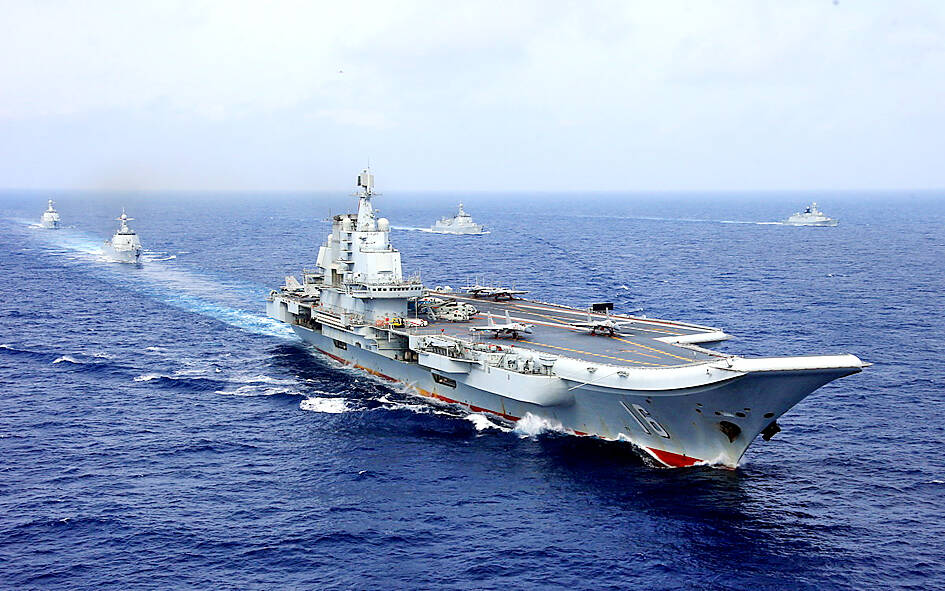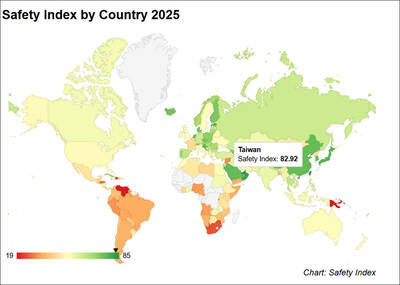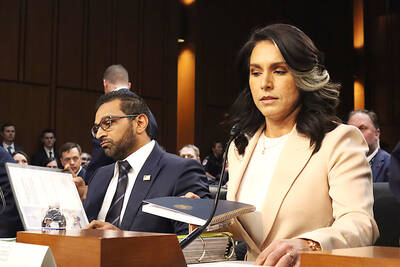The Ministry of National Defense said it was “on alert” as it detected a Chinese aircraft carrier group to Taiwan’s south yesterday amid concerns in Taiwan about the possibility of a new round of Chinese war games.
The ministry said in a statement that a Chinese navy group led by the carrier Liaoning had entered waters near the Bashi Channel, which connects the South China Sea and the Pacific Ocean and separates Taiwan from the Philippines.
It said the carrier group was expected to enter the Western Pacific.

Photo: Reuters
The military is keeping a close watch on developments and “exercising an appropriate vigilance and response,” the ministry added, without elaborating.
Based on a report released by the Japanese Joint Staff Office on Oct. 2, the Chinese Liaoning Carrier Strike Group was operating southeast of the Philippine main island of Mindanao and heading toward the Celebes Sea.
China has not ruled out using force to bring Taiwan under its control, and the Chinese military routinely operates around the nation.
President William Lai (賴清德) and his government reject Beijing’s sovereignty claims, saying only Taiwanese can decide their future.
It was not immediately clear if the latest deployment of the Liaoning is related to Taiwanese officials’ earlier warnings that China could launch another round of military drills following Lai’s Double Ten National Day address on Thursday last week.
In his speech, Lai said that the Republic of China (ROC) and the People’s Republic of China (PRC) not being subordinate to each other is an objective fact and reflects the current “status quo” across the Taiwan Strait.
Security sources had said before Lai’s address that his speech could prompt new Chinese war games, last held by the country in May in what Beijing said was “punishment” for Lai’s inauguration speech that month.
Earlier yesterday, the Chinese People’s Liberation Army’s Eastern Theater Command, which has responsibility for an area that includes Taiwan, put out a propaganda video on its social media accounts entitled “fully prepared and biding one’s time before battle.”
It showed fighter jets and warships operating together, mobile missile launchers being moved into place and amphibious assault vehicles, with a small map of Taiwan included in one of the Chinese characters that make up the video’s title.
The Chinese Ministry of National Defense did not answer calls outside of office hours yesterday.
China’s Taiwan Affairs Office did not immediately respond to a request for comment.
A Taiwanese security official, speaking on condition of anonymity given the sensitivity of the matter, told Reuters they were continuing to watch the situation around Taiwan, as well as Chinese media comments about Lai’s national day speech.
Chinese media has carried several commentaries and stories since Lai’s Thursday speech, denouncing it as “confrontational” and harmful.
A second security source based in Taiwan, familiar with intelligence assessments, said while it was still possible China — wary of creating a crisis over Taiwan so soon ahead of next month’s US presidential election — might keep its reaction to angry words, there remained the possibility of more war games.
China is in the middle of its annual drills season, and its military could just “hang a name” on those exercises and turn them into war games specifically targeting Taiwan, the official, also speaking anonymously, said.
The Chinese Ministry of Commerce on Saturday threatened Taiwan with more trade sanctions in what the government views as Chinese economic coercion.
Additional reporting by CNA

AIR SUPPORT: The Ministry of National Defense thanked the US for the delivery, adding that it was an indicator of the White House’s commitment to the Taiwan Relations Act Deputy Minister of National Defense Po Horng-huei (柏鴻輝) and Representative to the US Alexander Yui on Friday attended a delivery ceremony for the first of Taiwan’s long-awaited 66 F-16C/D Block 70 jets at a Lockheed Martin Corp factory in Greenville, South Carolina. “We are so proud to be the global home of the F-16 and to support Taiwan’s air defense capabilities,” US Representative William Timmons wrote on X, alongside a photograph of Taiwanese and US officials at the event. The F-16C/D Block 70 jets Taiwan ordered have the same capabilities as aircraft that had been upgraded to F-16Vs. The batch of Lockheed Martin

GRIDLOCK: The National Fire Agency’s Special Search and Rescue team is on standby to travel to the countries to help out with the rescue effort A powerful earthquake rocked Myanmar and neighboring Thailand yesterday, killing at least three people in Bangkok and burying dozens when a high-rise building under construction collapsed. Footage shared on social media from Myanmar’s second-largest city showed widespread destruction, raising fears that many were trapped under the rubble or killed. The magnitude 7.7 earthquake, with an epicenter near Mandalay in Myanmar, struck at midday and was followed by a strong magnitude 6.4 aftershock. The extent of death, injury and destruction — especially in Myanmar, which is embroiled in a civil war and where information is tightly controlled at the best of times —

Taiwan was ranked the fourth-safest country in the world with a score of 82.9, trailing only Andorra, the United Arab Emirates and Qatar in Numbeo’s Safety Index by Country report. Taiwan’s score improved by 0.1 points compared with last year’s mid-year report, which had Taiwan fourth with a score of 82.8. However, both scores were lower than in last year’s first review, when Taiwan scored 83.3, and are a long way from when Taiwan was named the second-safest country in the world in 2021, scoring 84.8. Taiwan ranked higher than Singapore in ninth with a score of 77.4 and Japan in 10th with

SECURITY RISK: If there is a conflict between China and Taiwan, ‘there would likely be significant consequences to global economic and security interests,’ it said China remains the top military and cyber threat to the US and continues to make progress on capabilities to seize Taiwan, a report by US intelligence agencies said on Tuesday. The report provides an overview of the “collective insights” of top US intelligence agencies about the security threats to the US posed by foreign nations and criminal organizations. In its Annual Threat Assessment, the agencies divided threats facing the US into two broad categories, “nonstate transnational criminals and terrorists” and “major state actors,” with China, Russia, Iran and North Korea named. Of those countries, “China presents the most comprehensive and robust military threat